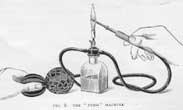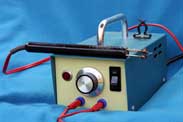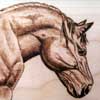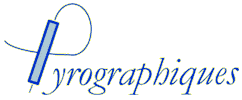Pyrography - "Designing with Fire"
by Susan Robey
From the Greek "pyros", fire, and "graphia", designing - pyrography involves using a heated implement to burn a design freehand into a surface; traditionally wood, but which may also be leather, paper, tagua, bone, velvet or even glass.
Some of the greatest artists from times past, including Turner, Rembrandt and Durer, devoted time and study to the manipulation of monotint. The warm sepia tint achieved with pyrography produces a similar effect.
A truly three dimensional art, pyrography is a combination of etching, painting and relief work while having all the freedom of a pen and ink drawing. Fine strokes suggest etching, while others resemble the broad unblended strokes of a brush - giving rise to the term "fire painting".
History
Pyrography is an ancient decorative art dating back at least as far as the 16th century, possibly even earlier.
The earliest instruments used were pokers or irons heated over a charcoal fire, but to achieve anything approaching an artistic effect with such crude tools required infinite patience and a great deal of skill. The main difficulty was the rapid cooling of the iron after being taken red hot from the fire. Some fine examples of early 19th century pyrography from the Pinto Collection can be seen at the Birmingham City Museum in England.
 It was in late Victorian times that the very first pyrography machines were developed. These early models comprised of a glass bottle filled with spirit or benzoline, rubber bellows and a platinum point connected via rubber tubing. The benzoline was pumped through and ignited to keep the point hot. Operating the bellows with one hand while working with the other must have been quite tricky, but it had the advantage of a constant temperature.
It was in late Victorian times that the very first pyrography machines were developed. These early models comprised of a glass bottle filled with spirit or benzoline, rubber bellows and a platinum point connected via rubber tubing. The benzoline was pumped through and ignited to keep the point hot. Operating the bellows with one hand while working with the other must have been quite tricky, but it had the advantage of a constant temperature.
With the advent of electricity, pyrography has evolved quite dramatically. Early electric machines such as the "Pyrolectric" and "Electricon" first appeared at the turn of the 20th Century. In the latter half of the century manufacturers developed and perfected specialist equipment, prompting renewed interest in the art.
Pyrography Today
 Modern electric pyrography machines have a means of regulating the heat, are designed for ease of use and enable precise control. Finely detailed work is therefore much more achievable. The outfit consists of a transformer with a calibrated dial, connected to which is a pen with an insulated handle. Depending on the model, this has a hot wire or solid point tip.
Modern electric pyrography machines have a means of regulating the heat, are designed for ease of use and enable precise control. Finely detailed work is therefore much more achievable. The outfit consists of a transformer with a calibrated dial, connected to which is a pen with an insulated handle. Depending on the model, this has a hot wire or solid point tip.
The pyrography pen is held in much the same way as any drawing implement. Although similar to using a conventional pen or pencil, it is far slower. Tonal variations are determined by the depth of the burn, depending not on pressure but on how long the point is in contact with the surface. Short, fast strokes produce a light burn; slow, steady ones a deep burn. Consequently, the development of a design is a very gradual process.
A variety of texture can be conveyed using traditional drawing techniques such as dots, stippling and cross hatching. "Pure burn" is normally sufficient for most subject matters, the sepia effect being part of the charm of this unusual art. In some cases, however, a little colour can enhance a piece still further as long as care is taken not to obliterate the pyrographic shading.
Pyrography is an art with limitless possibilities. The technological advances over recent years means it's full potential has yet to be realised.

